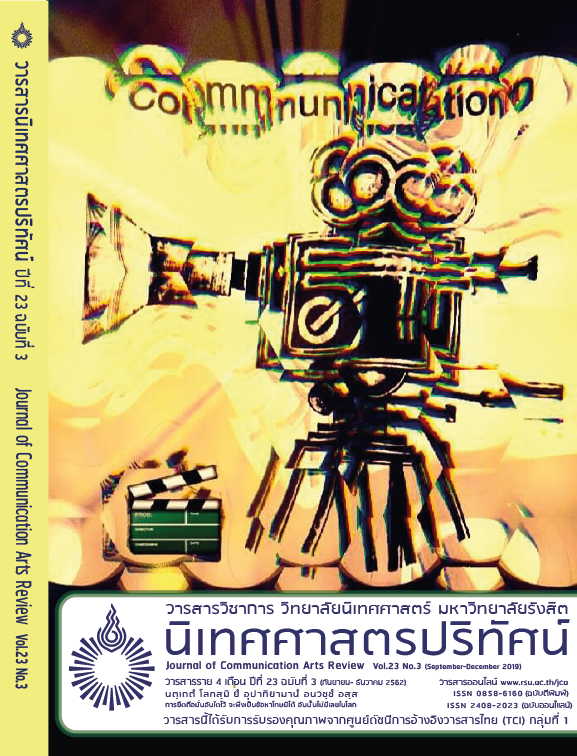นวัตกรรมการจัดการสื่อสารภายในองค์การเพื่อเสริมสร้างความผูกพันของ พนักงานต่อองค์การและประสิทธิผลของการปฏิบัติงานในองค์การชั้นนำของ ประเทศไทย
คำสำคัญ:
นวัตกรรม, การสื่อสารภายในองค์การ, ความผูกพันของพนักงานต่อองค์การ, ผลการปฏิบัติงานบทคัดย่อ
การวิจัยคร้ังนี้มีวัตถุประสงค์เพื่อ 1) ศึกษานวัตกรรมการจัดการส่ือสารภายในองค์การของพนักงานใน องค์การชั้นนำของประเทศไทย 2) ศึกษานวัตกรรมการจัดการสื่อสารภายในองค์การเพื่อเสริมสร้างความ ผูกพันของพนักงานต่อองค์การ และประสิทธิผลการปฏิบัติงานของพนักงานในองค์การชั้นนำของประเทศไทย ผู้วิจัยใช้วิธีวิจัยเชิงคุณภาพ โดยวิธีการสัมภาษณ์เจาะลึก จากผู้บริหารระดับสูงสุดขององค์การที่มีหน้าที่รับ ผิดชอบเกี่ยวกับการสื่อสารองค์การและด้านทรัพยากรมนุษย์ จาก 9 องค์การ ผลพบว่ากลยุทธ์การจัดการ สื่อสารภายในองค์การชั้นนำของประเทศไทย ได้แก่ กลยุทธ์ด้านการแบ่งกลุ่มเป้าหมาย กลยุทธ์การใช้ เทคโนโลยี กลยุทธ์การใช้เนื้อหา กลยุทธ์การใช้บริบท และกลยุทธ์การใช้บุคคลหรือพนักงาน โดยองค์การ จะนำนวัตกรรมทางด้านเทคโนโลยีมาใช้เป็นช่องทางติดต่อสื่อสารระหว่างพนักงานในองค์การผ่านโทรศัพท์ มือถือ ส่วนการใช้นวัตกรรมการจัดการสื่อสารภายในองค์การเพื่อสร้างความผูกพันของพนักงานต่อองค์การ และเพิ่มประสิทธิผลการปฏิบัติงานของพนักงาน ได้แก่ สื่อบุคคล สื่อเทคโนโลยี และสื่อกิจกรรม
เอกสารอ้างอิง
กานต์มณี แสงศรีจิราภัทร. (2550). การสื่อสารภายในองค์กรของบริษัท กสท โทรคมนาคม จำกัด(มหาชน). วิทยานิพนธ์นิเทศศาสตรมหาบัณฑิต สาขานิเทศศาสตรพัฒนาการ จุฬาลงกรณ์ มหาวิทยาลัย. [Kanmanee Sangsrijirapat. (2007). Internal communication of CAT Telecom Public Company Limited. Thesis for Master of Arts Program in Development Communication. Chulalongkorn University]
คารอส บุญสุภา และสฤษดิ์ ศรีโยธิน. (2559). “พฤติกรรมการใช้เครือข่ายสังคมในองค์กร” วารสารครุศาสตร์ปริทรรศน์ฯ 3,(1) (มกราคม-เมษายน). หน้า 21-14 [Carlos Boonsupa & Sarid Sriyothin.(2013). “Social Network Behavior in Organization.” Journal of Educational Review, 3 (1), PP. 21-14.]
ณัฏฐ์ชุดา วิจิตรจามรี. (2561). การสื่อสารในองค์กร. กรุงเทพ: มหาวิทยาลัยเกษตรศาสตร์. [Natchuda Wijitjammaree. (2018). Organizational communication (4th ed.). Bangkok: Kasetsart University Press.]
ปัทมา สมพรชัยกิจ. (2556). การสื่อสารภายในองค์การของสำนักเทศกิจ กรุงเทพมหานคร. รายงาน โครงการเฉพาะบุคคล วารสารศาสตรมหาบัณฑิต (การจัดการการสื่อสารองค์กร) คณะวารสารศาสตร์ และสื่อสารมวลชน มหาวิทยาลัยธรรมศาสตร์. [Pattama Sompornchaiyakij. (2018). Organization Communication of City Law Enforcement Department of Bangkok. Report Individual project for Master of Arts (Corporate Communication Management) Thammasat University.]
วิเชียร วิทยอุดม. (2547). พฤติกรรมองค์กร. นนทบุรี: ธีระฟิล์ม และไซเท็กซ์.[Wichian Wittaya-Udom. (2004). Organization behavior. Nonthaburi: Theera Film & Scitax.]
Argenti, P. (2009). Corporate Communication. New York: McGraw-Hill.
Block, B. (1989). “Creating a Culture all Employees can Accept” Management Review, 67 (July), 41-45.
Cascio W. F. (1995). Managing Human Resource Productivity, Quality of work Life, profits. New York: Mc Graw-Hill.
Cornelissen, J. (2004). Corporate Communications Theory and Practice. London: Sage.
Cornelissen, J. (2008). Corporate Communication A guide to theory and practice. London: SAGE.
Cutlip, S.M. & Center, A.H. (1952). Effective public relations: pathways to public favor. New York: Prentice-Hall
Daniels, T.D., Spiker, K. & Papa, J.M. (1997). Perspectives on Organizational Communication. (4th ed). Boston: McGraw-Hill.
Goodman, M.B. & Hirsch, P.B. (2010). Corporate Communication., New York: Peter Lang.
Goodman, M.B., Genst, C., Bettoli, K., Templo, L., & Wolman, L. (2013). CCI Corporate Communication Practices and Trends Study 2013. New York : Corporate Communication International,
Haviland, W.A. (1993). Cultural Anthropology. (7th ed.). Fort Worth, Texas: Harcourt Brace Jovanovich.
Hodgetts, R.M. & Hegar, K.W. (2005). Modern Human Relations at work (9thed). South-Western, USA: Thomson.
Jue, A. L., Marr, J. A., & Kassotakis, M. E. (2010). Social media at work: How networking tools propel organizational performance. San Francisco : Jossey-Bass.
Kalla, H.A. (2005). “Integrated internal communications: A multidisciplinary perspective Corporate Communication” An International Journal, 10 (4), PP.302–314.
Macey, W.H. & Schneider, B. (2008). “The Meaning of Employee Engagement” Industrial and Organizational Psychology, 1(1), PP. 3-30.
Macleod, D. & Clarke, N. (2009). Engaging for success: enhancing performance through employee engagement. A Report to the Government, Department of business, Innovation and Skills. London, Crown Copyright.
Mazzei, A. (2014). “Internal communication for employee enablement: Strategies in American and Italian companies” Corporate Communications An International Journal, 19 (1), PP. 82-95.
Meyer, J.P. & Allen, N.J. (1991). “A three-component conceptualization of organizational Commitment” Human Resource Management Review, 1 (1), PP. 61-89.
Neher, W. W. (1997). Organizational communication: Challenges of Change, Diversity, and Continuity. Boston: Allyn and Bacon.
Papalexandris, N. & Galanaki, E. (2009). “Leadership’s impact on employee engagement: differences among entrepreneurs and professional CEOs” Leadership & Organization Development Journal, 30 (4), PP. 365-85.
Quirke, B. (2000). Making the Connections: Using Internal Communications to Turn Strategy into Action, Aldershot: Gower.
Robertson-Smith, G. & Markwick, C. (2009). Employee Engagement A review of current thinking. Report 469. Brighton UK: Institute for Employment Studies.
Thill, V.J & Bovee, C.L. (2010). Excellence in business communication (10th ed.). New jersey: Pearson education.
Tourish, D., & Hargie, O. (2000). “Auditing communication to maximise performance” In O.Hargie & D. Tourish (Eds.), Handbook of Communication Audits for Organisations. London: Routledge.
Tourish, D. & Hargie, O. (2004). “Motivating critical upward communication: a key challenge for management decision making” in Tourish, D. and Hargie, O. (Eds), Key Issues in Organizational Communication. London: Routledge.
Tourish, D., & Hargie, O. (2009). “Communication and organisational success” In O. Hargie, & D. Tourish (Eds.), Auditing organisational success. London: Routledge.
Welch, M. & Jackson, P.R. (2007) “Rethinking internal communication: a stakeholder approach Corporate Communications” An International Journal, 12 (2), PP. 177-98.
Verghese, A.K., (2017). “Internal Communication: Practices and Implications” SCMS Journal of Indian Management, PP. 103-113.
Yates, K. (2006). “Internal Communication Effectiveness Enhances Bottom - Line Results” Journal of Organizational Excellence, 25 (3), PP. 71-79.
Yates, K. (2008). “Becoming an ROI builder: Delivering effective employee communication” Employee Relations, 35, PP. 19-23.
Zaremba, A. J. (2010). Organization Communication (3rd ed.). New York: Oxford University Press.
เว็บไซต์
Denise Cox. (2014). Delivering effective internal communications delivering ROI through employee engagement. Industry Benchmark Analysis & Best Practice Advice. Newsweaver powering communication. Retrieved January 15, 2015, from http://cdn2.hubspot.net/hub/301060/file551356727pdf/Whitepapers_PDF/Effective_ICv2.pdf?t=1393497886000
Gallup. (2012). Employee engagement. Retrieved January 15, 2015 from http://www.gallup.com/consulting/52/employee-engagement.aspx
Opitz, I. & Hinner, M.B. (2003). Good internal communication increases productivity, Freiberg Working Papers 2003/07, Technical University Bergakademie Freiberg, Faculty of Economics and Business Administration. Retrieved January 15, 2015, from http://hdl.handel.net/10419/48382
The Joint Commission. (2010). Advancing Effective Communication, Cultural Competence, and Patient- and Family-Centered Care: A Roadmap for Hospitals. Oakbrook Terrace, IL: The Joint Commission. Retrieved January 15, 2015, From https://www.jointcommission.org/assets/1/6/ARoadmapforHospitalsfinalversion727.pdf
Zaineb, A. (2010). Barriers to Effective Communication in an Organization and Overcoming it. Retrieved June 17, 2015 from http://blog.commlabindia.com/elearning-design/barriers-to-communication


